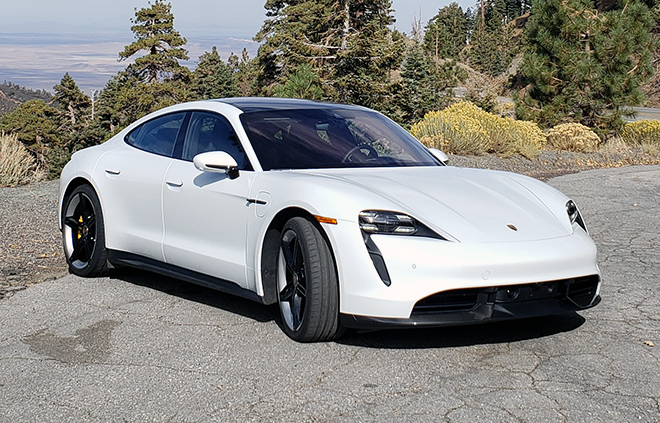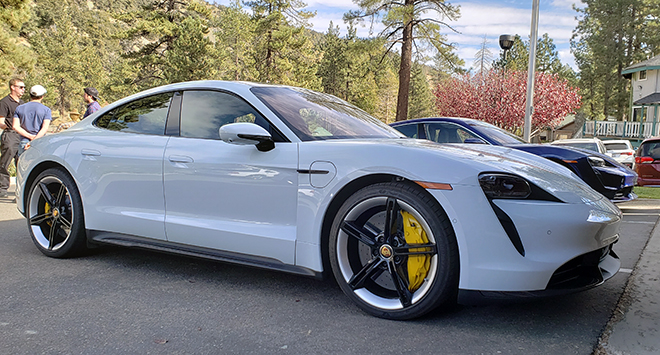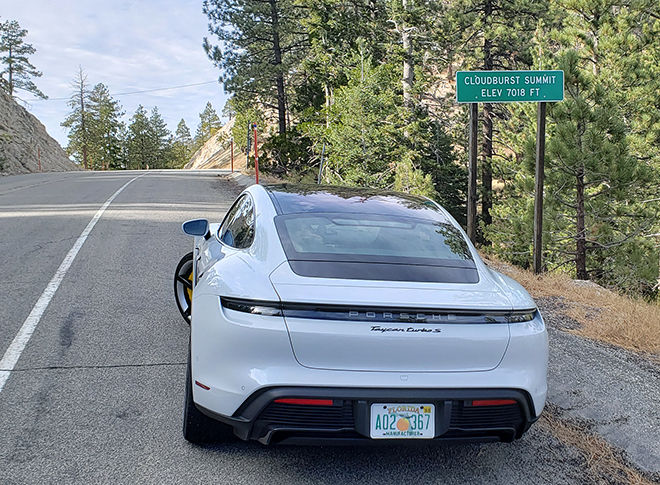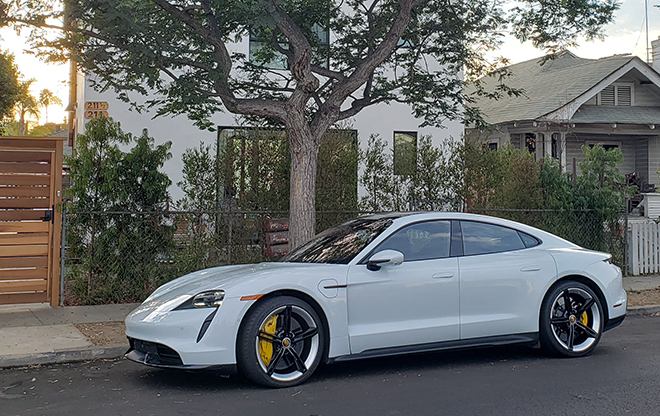Even experienced auto writers approach driving high-performance cars with caution. If you mostly test mass-market cars, as I do, trepidation may creep in: Will I be able to do this car justice? Will it be manageable on the road? Are there special steps I should take to avoid damaging a car that costs six figures?
It took less than 5 minutes in the 2020 Porsche Taycan electric sport sedan to lay these fears to rest. The brand’s first electric car is as easy to drive as any other EV, and considerably more so than sports cars – Ferraris, Lamborghinis, and McLarens – whose raw power it equals and in some case surpasses.
Few things are more blissful than being given the key to a Taycan for a day, knowing you’re the only driver for more than 200 miles – and being able to take it along the Angeles Crest Highway, one of the twistier of Southern California’s many sweeping mountain roads.
On a mid-November weekday, it was stunningly empty. I nodded to a 1960s Alfa Romeo and a pair of old air-cooled Porsche 911s as they passed in the other direction. A few commercial trucks and two very unhappy-looking cyclists were most of the rest of the traffic.


Yesterday, EPA range figures for the 2020 Taycan Turbo were released, and they were disappointing: 201 miles combined. That rating represents a much greater reduction from the WLTP range estimate (used in Europe) than most other EVs show. On that cycle, the Taycan Turbo is rated at 236 to 279 mi (380 to 450 km). Porsche suggests many U.S. owners will find their average range is closer to 240 miles.
The range news didn’t go over well among many commentators, and Tesla fans had a virtual field day with the news. My test of a Turbo S, a variant that hasn’t yet been EPA-rated, didn’t take the car right down to 0%. Porsche scheduled a fast-charging stop about three-quarters of the way through the day’s 210-mile drive route.
Driving # 101
The white test car was a pre-production 2020 Porsche Taycan Turbo S. It has no turbo, of course, but that’s a familiar model designation to existing Porsche owners – presently the top of the range, with a sticker price that can surpass $250,000 if heavily optioned. Its VIN ended in 00101, showing just how early it was. Equipment variations that included a lack of blind-spot alerts meant it would never be sold to retail buyers in the U.S., but otherwise it felt and drove every bit like a regular production model.
The Taycan is low and sleek for a four-door sedan, with a steeply raked windscreen. Entering and exiting requires a bit of practice to accomplish smoothly, especially for men of many decades. Once in, the seats were multiply adjustable, heavily bolstered, and very comfortable for energetic driving – which is what Porsche is all about.


As you may have read by now, the brand’s first-ever electric car has been designed to be just another model in Porsche’s lineup. Its creators kept the driving experience, controls, and cockpit feel as similar as possible to the rest of the lineup.
I wondered if the lack of one-pedal driving, or even lift-off regeneration in Normal mode, might make this a strange electric car to drive. (The car simply glides when the driver lifts off: No power is delivered, and only aerodynamic drag and rolling resistance lowers the car’s speed.) Drivers must use the brake pedal to slow down, though most of that slowing comes from regenerative braking alone, up to 270 kilowatts.
Forgetting the EV part
I needn’t have worried. In fact, I forgot the Taycan was electric more quickly than any other EV I’ve tested. That list of cars now numbers about three dozen vehicles, from Tesla down to Mitsubishi.
And that means Porsche has succeeded in its mission of making a superbly capable electric car that is, first and foremost, a Porsche.
Outward visibility is good to the front, where the driver looks at the road directly ahead between the bulges of the front fenders, and to the side, where the low window line helps. The glass roof both provides more headroom and makes the tight cabin feel roomier. The steep back window gives only a slit-like view through the rear-view mirror, though, and reversing requires careful use of mirrors, camera, and proximity sensors.


The acceleration is prodigious, and delivered more smoothly than a few fast EVs that punch you in the back on launch. It gathers silently, delivering speeds above 60 mph in less than 4 seconds and continuing to three-digit velocities shockingly fast.
Sport mode alters the shift points for the two-speed gearbox mounted to the rear motor. Switching from Normal into Sport mode around 45 mph, the Taycan made a notable “thunk,” which turned out to be an unexpected downshift to first gear for greater acceleration.
The roadholding quickly proved to exceed my capabilities and courage, so I’ll leave it to race-trained reviewers to measure the ultimate limits.
No body roll
That said, the Taycan was confident and planted – with no squeal from remarkably wide 21-inch tires – at cornering speeds up to twice recommended limits. Body roll is almost entirely absent. The “brakes” were equally impressive at hauling the car down from high speeds, and any transition between regeneration and friction brakes was indiscernible.
It’s a remarkably quiet car inside, even at very high speeds. Porsche has provided a synthesized “performance sound” that rises as power is applied and speed increases. It says that will appeal to its traditional buyers, whereas EV-savvy buyers new to Porsche probably won’t use it. I found it remarkably annoying, and kept it off for the duration.
In temperate Southern California weather, the car was delivered with range showing slightly above 200 miles. Porsche scheduled a stop at the Electrify America charging stations in Burbank, where I added 53 kilowatt-hours to the battery, taking its charge from 23 percent to 80 percent in 24 minutes.
For road trips, especially in winter weather, owners will have to contend with a presently spotty network of 350-kw charging sites, just as Tesla owners did five years ago at (lower-speed) Supercharger locations. EA has reportedly suffered reliability problems with some of their sites; the one location tested worked just fine.


Miles? Kilometers?
The pre-production test Taycan had a few stay electronic gremlins in the infotainment system. They included “rear-light fault” and “door open” messages that appeared while driving and audio navigation directions that switched into kilometers, even as the screen showed miles. None of these interfered at all with driving enjoyment of this fast, pricey, very capable electric sport sedan.
And that was the bottom line: This was the most enjoyable EV I’ve ever driven. At prices that start at $105,000 and can exceed a quarter of a million dollars, it should be. Nonetheless, it took a day’s driving to understand just what Porsche meant when it said, “We built a Porsche that happens to be electric.”
I was an hour late delivering the car back at the end of the drive, just because it was so much fun to drive. Of several hundred cars I’ve tested over the last decade, this was the one I least wanted to give back. That bodes well for future Porsche electric cars.
To date, the Taycan lineup starts with the 4S ($103,800; 79.2-kwh pack), the Taycan Turbo sits in the middle, and the Taycan Turbo S (prices up to $250,000; 93.4-kwh battery) is at the top end.


Photos by John Voelcker. Porsche provided airfare, lodging, and meals to allow Charged to bring you this first-person drive report.

























